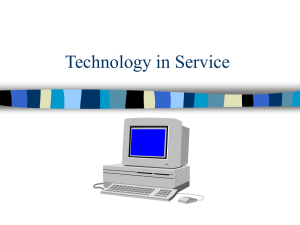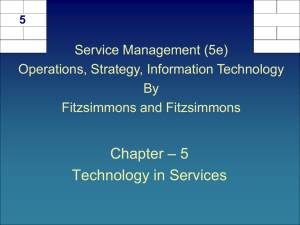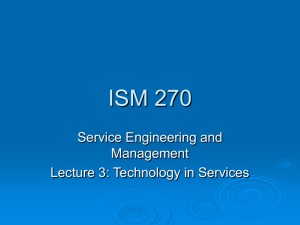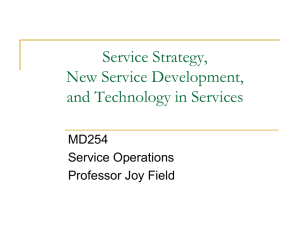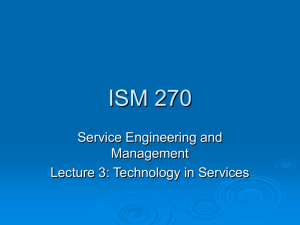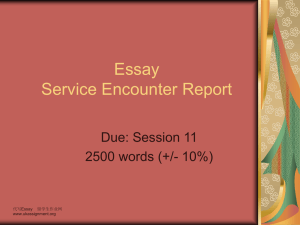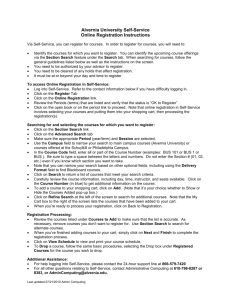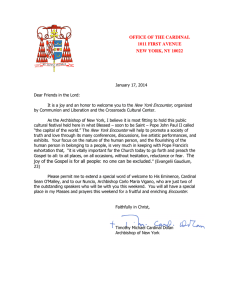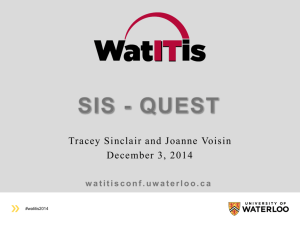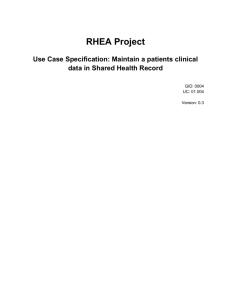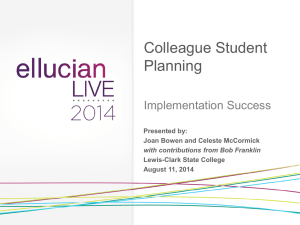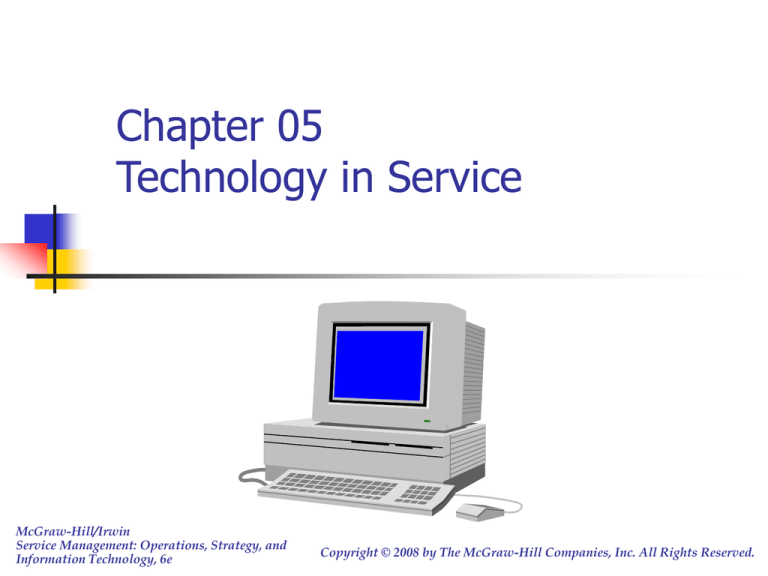
Chapter 05
Technology in Service
McGraw-Hill/Irwin
Service Management: Operations, Strategy, and
Information Technology, 6e
Copyright © 2008 by The McGraw-Hill Companies, Inc. All Rights Reserved.
Learning Objectives
Describe the five roles of technology in the service
encounter.
Give industry examples of the evolution of selfservice from human contact, to machine assisted, to
electronic service.
Describe the eight uses of web sites.
Describe and differentiate the eight generic Ebusiness models.
Explain what is meant by scalability an how its is
relevant to E-commerce.
Describe the managerial issues associated with the
adoption of new technology.
5-2
Role of Technology in the Service
Encounter
Technology
Customer
Technology
Server
A. Technology-Free
Service Encounter
Customer
Technology
Server
B. Technology-Assisted
Service Encounter
Technology
Customer
Customer
Server
C. Technology-Facilitated
Service Encounter
Technology
Server
D. Technology-Mediated
Service Encounter
Customer
Server
E. Technology-Generated
Service Encounter
5-3
Evolution of Self-service
Service Industry
Human Contact
Machine Assisted
Internet Facilitated
Banking
Teller
ATM
Online banking
Grocery
Checkout clerk
Self-checkout station
Online order/ pickup
Airlines
Ticket agent
Check-in kiosk
Print boarding pass
Restaurants
Wait person
Vending machine
Online order/ delivery
Movie theater
Ticket sale
Kiosk ticketing
Pay-for-view
Book store
Information clerk
Stock-availability terminal
Online shopping
Education
Teacher
Computer tutorial
Distance learning
Gambling
Poker dealer
Computer poker
Online poker
5-4
Self-service Technologies
(SST) Challenges
Does customer adoption of self-service follow
a predictable pattern?
How do we measure self-service quality (e.g.,
ease of use, enjoyment, and/or control)?
What is the optimal mix of SST and personal
service for a service delivery system?
How do we achieve continuous improvement
when using SST?
What are the limits of self-service given the
loss of human interaction?
5-5
Classification of Service
Automation
Fixed-sequence (F) - parking lot gate
Variable-sequence (V) - ATM
Playback (P) - answering machine
Numerical controlled (N) - animation
Intelligent (I) - autopilot
Expert system (E) - medical diagnosis
Totally automated system (T) - EFT
5-6
Technology Convergence
Enabling E-Business
Internet
Global telephone system
Communications standard TCP/IP
(Transfer Control Protocol/Internet Protocol)
Addressing system of URLs
Personal computers and cable TV
Customer databases
Sound and graphics
User-friendly free browser
5-7
Purpose of Web-sites
Retail channel (Amazon.com)
Supplemental channel (Barnes & Nobel)
Technical support (Dell Computer)
Embellish existing service (HBS Press)
Process orders (Delta Airline)
Convey information (Kelly Blue Book)
Communicate with membership (POMS.org)
Play games (Treeloot.com)
5-8
Electronic and Traditional
Services
Features
Virtual
Physical
Encounter
Screen-to-face
Face-to-face
Availability
Anytime
Working hours
Access
From anywhere
Travel to location
Market Area
Worldwide
Local
Ambiance
Payment
Electronic
interface
Credit card
Physical
environment
Cash or check
Differentiation
Convenience
Personalization
Privacy
Anonymity
Social interaction
5-9
Grocery Shopping Comparison
On-line
Shopping
Advantages
Convenience
Saves time
Less impulse
buying
Disadvantages Forget items
Less control
Need computer
Delivery fee
Traditional
Shopping
See new items
Memory trigger
Product sampling
Social interaction
Time consuming
Waiting lines
Carry groceries
Impulse buying
5-10
E-Business Models
Content Provider: Reuters
Direct-to-Customer: Dell
Full-Service Provider: GE Supply Co.
Intermediary: eBay
Shared Infrastructure: SABRE
Value Net Integrator: 7-Eleven Japan
Virtual Community: Monster.com
Whole-of-Enterprise: Government
5-11
Economics of E-Business
Sources of Revenue:
- Transaction fees
- Information and advice
- Fees for services and commissions
- Advertising and listing fees
Ownership
- Customer relationship
- Customer data
- Customer transaction
5-12
Economics of Scalability
Dimensions
High
Scalability
Low
E-commerce
continuum
Selling
information
(E-service)
Selling valueadded service
Selling
services with
goods
Selling goods
(E-commerce)
Information vs. Goods
Content
Information
dominates
Information with
some service
Goods with support
services
Goods dominate
Degree of Customer
Content
Self-service
Call center backup
Call center support
Call center order
processing
Standardization vs.
Customization
Mass distribution
Some
personalization
Limited
customization
Fill individual orders
Shipping and Handling
Costs
Digital asset
Mailing
Shipping
Shipping, order
fulfillment, and
warehousing
After-sales service
None
Answer questions
Remote maintenance
Returns possible
Example Service
Used car prices
Online travel agent
Computer IT support
Online retailer
Example Firm
Kbb.com
Biztravel.com
Everdream.com
Amazon.com
5-13
Adoption of New Technology in
Services
Challenges of Adopting New Technology
The Process is the Product
Back Office vs Front Office Changes
Need for Standardization
Readiness to Embrace New Technology
The Case of Radio Frequency Identification
5-14
Topics for Discussion
1.
2.
3.
4.
5.
Can an Internet service encounter be a
memorable experience?
How does the economics of scalability
explain the failure of Living.com, an online
furniture retailer?
What are the characteristics of early
adopters of self-service?
How can we design for self-recovery when
self-service failure occurs?
What could be the explanation for the high
customer satisfaction scores in Table 5.6 for
Internet services?
5-15
Amazon.com
How would you contrast Amazon’s business
design with that of Barnes & Noble before
Barnes & Noble went online?
What are the advantages and disadvantages
of each of the two designs?
Is Amazon.com a model for the future of
retailing?
5-16

